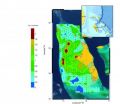(Press-News.org) New York, NY - July 24, 2014 -- Keryx Biopharmaceuticals, Inc. (Nasdaq:KERX) (the "Company") announced the publication of results from the long-term, randomized, active control Phase 3 study of Zerenex (ferric citrate), the Company's investigational oral ferric iron-based phosphate binder, for the treatment of hyperphosphatemia in patients with end-stage renal disease (ESRD) on dialysis. The PERFECTED study (PhosphatE binding and iRon delivery with FErric CiTrate in EsrD) was published online today in the Journal of the American Society of Nephrology (JASN).
This Phase 3 study was a multicenter, randomized, open-label trial in 441 ESRD patients on hemodialysis or peritoneal dialysis designed to determine the safety and efficacy of Zerenex as a treatment to reduce serum phosphorus as well as raise iron stores and reduce intravenous (IV) iron and erythropoietin-stimulating agents (ESA) usage.
Zerenex met the study's primary end-point demonstrating a highly statistically significant change in serum phosphorus versus placebo over the four-week Placebo Control Period. Using a sequential gatekeeping strategy for the key pre-defined secondary end-points, Zerenex also demonstrated statistically significant increases in serum ferritin and transferrin saturation (TSAT), and significant reductions in the use of IV iron and ESAs, versus an active control of Renvela® (sevelamer carbonate) and/or Phoslo® (calcium acetate) over the 52-week Active Control Period of the study. In addition, mean hemoglobin levels were higher in subjects treated with Zerenex as compared to subjects treated with active control.
"Zerenex effectively reduces serum phosphorus levels within the KDOQI range (3.5 mg/dL to 5.5 mg/dL) while having the additional patient benefits of increasing iron stores and decreasing the need for IV iron and ESAs, while maintaining hemoglobin levels," said Julia Lewis, MD, lead investigator, nephrologist and Professor of Medicine at Vanderbilt University Medical Center. "If approved, the combined benefits of Zerenex would be of value for patients, health care professionals and the healthcare system."
The Company's New Drug Application (NDA) for Zerenex is currently under review by the U.S. Food and Drug Administration (FDA).
Ron Bentsur, Chief Executive Officer of Keryx, commented, "We are very pleased with the publication of the Phase 3 PERFECTED study results in a premier peer-reviewed nephrology journal and are encouraged by Zerenex's potential differentiated product profile." Mr. Bentsur added, "We thank the investigators and patients who participated in this study and look forward to potentially bringing Zerenex to market in the U.S."
Phosphorus Control is Necessary for Most ESRD Patients on Dialysis
In the United States, according to data from the U.S. Renal Data System, there are currently approximately 600,000 ESRD patients, with the number of ESRD patients projected to rise in the future. The majority of ESRD patients in the United States, more than 400,000, require dialysis. Phosphate retention and the resulting hyperphosphatemia in patients with ESRD on dialysis are associated with secondary hyperparathyroidism, renal osteodystrophy, soft tissue mineralization and an increase in adverse cardiovascular events. Hyperphosphatemia is ubiquitous in ESRD, with the majority of the patients requiring chronic treatment with phosphate-binding agents to lower and maintain serum phosphorus at acceptable levels.
Zerenex Administration Over 52 Weeks Increased Iron Stores
In addition, approximately seventy percent of dialysis patients are truly or functionally iron depleted, suffer from anemia and require treatment with IV iron and/or ESA injections. The newly published clinical trial results show that, in addition to its efficacy as a phosphate binder, Zerenex also significantly raises iron stores as measured by serum ferritin and TSAT.
The results showed Zerenex demonstrated a statistically significant treatment difference versus the active control group in mean change in serum ferritin (+306 ng/mL vs. +19 ng/mL) and TSAT (+8% vs -1.2%) from baseline (day 0) to week 52. In the PERFECTED study, subjects randomized to receive Zerenex required significantly lower dosages of IV iron and ESA; and hemoglobin levels were higher in Zerenex treated patients than in those receiving active control.
The investigators cited an analysis of the trial results that indicated that the projected reduction in the need for IV iron and ESA use would result in significant pharmaco-economic benefits. In addition, the investigators wrote, "one would postulate that decreased IV iron and ESA usage could result in decreased nursing time to administer IV medications which could be redirected to other aspects of patient care and decreased risk of infections due to fewer IV injections." In the PERFECTED study, fewer serious adverse events (SAEs) due to infection were seen in the subjects randomized to Zerenex compared to active control.
The authors noted that, if approved, Zerenex would be the only phosphate binder that also increases iron stores and decreases IV iron and ESA use.
Study Design and Results
Subjects in the PERFECTED study (n=441) first entered a 2-week washout period and were then randomized in a 2:1 ratio to receive either Zerenex or an active control of Renvela® (sevelamer carbonate) and/or Phoslo® (calcium acetate) for a 52-week Active Control Period. This was then followed by a 4-week Placebo Control Period in which Zerenex subjects were again randomized to either continue on Zerenex or switch to placebo. Zerenex was administered as 1 gram tablets each containing 210 mg of ferric iron. Active control study drugs were administered as calcium acetate 667 mg capsules, sevelamer carbonate 800 mg tablets alone or in combination.
The primary end-point of this trial was the mean change in serum phosphorus from baseline (Week 52) to the end of the 4-week Placebo Control Period. A prospectively designed sequential gatekeeping strategy controlled study-wise type 1 error for serum ferritin, TSAT, IV iron and ESA usage as pre-specified secondary endpoints in the 52-week Active Control Period.
The primary end-point demonstrated mean serum phosphorus was lower in the ferric citrate group versus the placebo group with a mean treatment difference of -2.2 ± 0.2 mg/dL (P END
Zerenex™ (ferric citrate) long-term Phase 3 study results published in JASN
Data demonstrate the drug candidate's potential to become the first phosphate binder to increase iron stores while reducing the need for IV iron and erythropoiesis-stimulating agents in end-stage renal disease patients on dialysis
2014-07-25
ELSE PRESS RELEASES FROM THIS DATE:
New research suggests Saharan dust is key to the formation of Bahamas' Great Bank
2014-07-25
MIAMI – A new study suggests that Saharan dust played a major role in the formation of the Bahamas islands. Researchers from the University of Miami (UM) Rosenstiel School of Marine and Atmospheric Science showed that iron-rich Saharan dust provides the nutrients necessary for specialized bacteria to produce the island chain's carbonate-based foundation.
UM Rosenstiel School Lewis G. Weeks Professor Peter Swart and colleagues analyzed the concentrations of two trace elements characteristic of atmospheric dust – iron and manganese – in 270 seafloor samples collected along ...
Overweight and obese preschoolers lose more weight when parent is also treated
2014-07-24
BUFFALO, N.Y. – Primary care treatment of overweight and obese preschoolers works better when treatment targets both parent and child compared to when only the child is targeted, according to research published this week in Pediatrics and conducted at the University at Buffalo and Women and Children's Hospital of Buffalo.
Children enrolled in this study were overweight or obese and had one parent who participated in the study who also was overweight or obese, according to body mass index (BMI) measurements, calculated based on height and weight.
During the course of the ...
NYSCF scientists one step closer to cell therapy for multiple sclerosis patients
2014-07-24
NEW YORK, NY (July 24, 2014) – Scientists at The New York Stem Cell Foundation (NYSCF) Research Institute are one step closer to creating a viable cell replacement therapy for multiple sclerosis from a patient's own cells.
For the first time, NYSCF scientists generated induced pluripotent stem (iPS) cells lines from skin samples of patients with primary progressive multiple sclerosis and further, they developed an accelerated protocol to induce these stem cells into becoming oligodendrocytes, the myelin-forming cells of the central nervous system implicated in multiple ...
Study indicates large raptors in Africa used for bushmeat
2014-07-24
Bushmeat, the use of native animal species for food or commercial food sale, has been heavily documented to be a significant factor in the decline of many species of primates and other mammals. However, a new study indicates that more than half of the species being consumed are birds, particularly large birds like raptors and hornbills.
"By surveying not only the meat made available for sale but the meat that is being eaten inside the forest by hunters and brought to villages for consumption, we noted a significant percentage attributed to bird species," said Bethan ...
New study draws links between wildlife loss and social conflicts
2014-07-24
Citing many sobering examples of how wildlife loss leads to conflict among people around the world, a new article co-authored by Wildlife Conservation Society (WCS) Health & Ecosystems: Analysis of Linkages (HEAL) Program Director Dr. Christopher Golden, calls for an interdisciplinary approach to tackle global biodiversity decline.
The harvest of wild animals directly supports about 15% of the world's people and provides protein for more than a billion of the world's poor. It should come as no surprise that today's unprecedented loss of wildlife, is bringing with it ...
Hubble finds 3 surprisingly dry exoplanets
2014-07-24
Astronomers using NASA's Hubble Space Telescope have gone looking for water vapor in the atmospheres of three planets orbiting stars similar to the sun -- and have come up nearly dry.
The three planets, known as HD 189733b, HD 209458b, and WASP-12b, are between 60 and 900 light-years away from Earth and were thought to be ideal candidates for detecting water vapor in their atmospheres because of their high temperatures where water turns into a measurable vapor.
These so-called "hot Jupiters" are so close to their star they have temperatures between 1,500 and 4,000 degrees ...
The microbes make the sake brewery
2014-07-24
A sake brewery has its own microbial terroir, meaning the microbial populations found on surfaces in the facility resemble those found in the product, creating the final flavor according to research published ahead of print in the journal Applied and Environmental Microbiology. This is the first time investigators have taken a microbial census of a sake brewery.
Many sake makers inoculate with both bacteria and yeast, says corresponding author David A. Mills of the University of California, Davis, but he and his colleagues investigated a sake brewery where inoculation ...
New imaging agent provides better picture of the gut
2014-07-24
MADISON — A multi-institutional team of researchers has developed a new nanoscale agent for imaging the gastrointestinal (GI) tract. This safe, noninvasive method for assessing the function and properties of the GI tract in real time could lead to better diagnosis and treatment of gut diseases.
Illnesses such as small bowel bacterial overgrowth, irritable bowel syndrome and inflammatory bowel disease all occur in the intestine and can lead to serious side effects in patients with diseases such as diabetes and Parkinson's.
Until now, there hasn't been a good way to ...
Brain's dynamic duel underlies win-win choices
2014-07-24
People choosing between two or more equally positive outcomes experience paradoxical feelings of pleasure and anxiety, feelings associated with activity in different regions of the brain, according to research led by Amitai Shenhav, an associate research scholar at the Princeton Neuroscience Institute at Princeton University.
In one experiment, 42 people rated the desirability of more than 300 products using an auction-like procedure. Then they looked at images of paired products with different or similar values and were asked to choose between them. Their brain activity ...
TGen-led study seeks to understand why some HIV-positive men are more infectious
2014-07-24
FLAGSTAFF, Ariz. — July 24, 2014 — A new study led by the Translational Genomics Research Institute (TGen) provides insights into the interplay among bacteria, viruses and the immune system during HIV infection.
Currently, doctors measure HIV-positive men's infectivity — their potential to infect others — based on their blood viral load. However, some men produce large amounts of virus in their semen despite having low levels in their blood. Researchers call this "compartmentalization," where different levels of the virus can be found in different parts of the body; in ...
LAST 30 PRESS RELEASES:
Child pedestrians, self-driving vehicles: What’s the safest scenario for crossing the road?
Mount Sinai researchers the first to apply single-cell analysis to reveal mechanisms of a common complication of Crohn’s disease
Scientists unveil genetics behind development of gliding
Safety of ancestral monovalent COVID-19 vaccines in children
Reversals in the decline of heart failure mortality in the US
Recreational marijuana laws and teen marijuana use, 1993-2021
Manchester scientists found novel one-dimensional superconductor
Tumor cells evade the immune system early on: Newly discovered mechanism could significantly improve cancer immunotherapies
Children with skin diseases suffer stigma, bullying and depression
A novel universal light-based technique to control valley polarization in bulk materials
Vast DNA tree of life for flowering plants revealed by global science team
Mini-colons revolutionize colorectal cancer research
Lead-vacancy centers in diamond as building blocks for large-scale quantum networks
JMIR Rehabilitation and Assistive Technologies announces theme issue on participatory methods in rehabilitation research
SwRI’s Dr. Marc Janssens recognized for role in establishing cone calorimeter fire testing
Modeling broader effects of wildfires in Siberia
Researchers find oldest undisputed evidence of Earth’s magnetic field
Eric and Wendy Schmidt announce 2024 Schmidt Science Fellows
Paclitaxel-induced immune dysfunction and activation of transcription factor AP-1 facilitate Hepatitis B virus replication
Single-walled carbon nanotubes doped with ‘nitrogen’ enhance the performance of secondary battery anode
Pioneering the future of urban traffic: The revolutionary spatiotemporal-restricted a* algorithm
First-ever combined heart pump and pig kidney transplant gives new hope to patient with terminal illness
FAU receives grant to examine role of pet dogs on military adolescents
COVID-19 pandemic alters view that doctors are obligated to provide care
This salt battery harvests osmotic energy where the river meets the sea
On the trail of deepfakes, Drexel researchers identify ‘fingerprints’ of AI-generated video
Virtual reality can motivate people to donate to refugee crises regardless of politics
Holographic displays offer a glimpse into an immersive future
Novel Au-BiFeO3 nanostructures for efficient and sustainable degradation of pollutants
It takes two to TANGO: New strategy to tackle fibrosis and scarring
[Press-News.org] Zerenex™ (ferric citrate) long-term Phase 3 study results published in JASNData demonstrate the drug candidate's potential to become the first phosphate binder to increase iron stores while reducing the need for IV iron and erythropoiesis-stimulating agents in end-stage renal disease patients on dialysis




